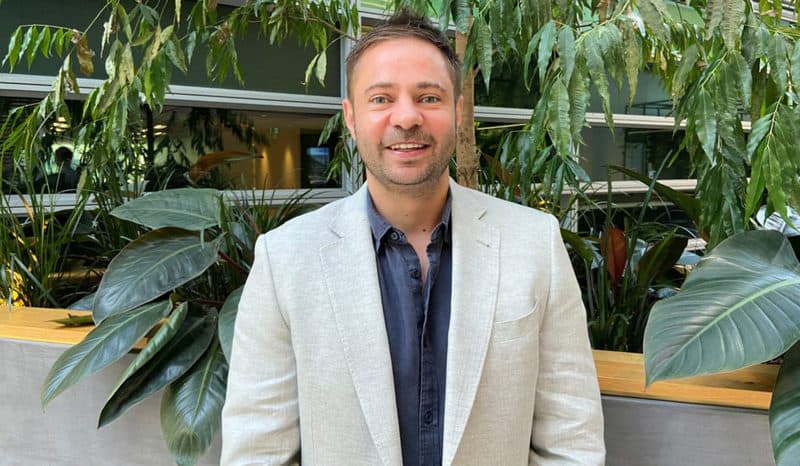In a week where SMI detailed a record ad spend in calendar 2021, key players from the companies that are behind ThinkPremiumDigital share their thoughts about digital ad spend in the year ahead with Mediaweek.
Foxtel’s Chris Oxley, Seven’s Gereurd Roberts, News Corp’s Michael Krawczyk, 10 CBSViacom’s Rod Prosser and Nine’s Ben Campbell speak on digital ad spend trends, BVOD growth, and digital ad strategies.

Foxtel Media’s Chris Oxley
Chris Oxley, National Head of Digital Sales, Foxtel Media
Given its trajectory, digital ad spend is almost guaranteed to increase in 2022. What are macro trends within that you are seeing that will play out in the year ahead?
Content will continue to be king.
Live sport and must-see live entertainment will continue to be the main drivers. There is already an increased focus on attention and engagement (Foxtel audiences as an example are 27% more engaged), which is highlighting that shorter ad loads mean better experiences for advertisers and subscribers.
BVOD experienced a record-breaking year in 2021 as more advertisers embraced it. What’s new for BVOD in 2022?
Premium entertainment content will continue to be provided by leading global distributors (both new content and access to deep back catalogue content) – our library is stacked with powerhouse storytellers from HBO, BBC, NAT GEO, NBCU, Discovery and more, combined with powerful locally produced content resulting in an ongoing unrivalled selection for on demand viewers.
The lines between TV and Digital will also continue to merge and the industry will begin talking about a ‘total video experience’ as opposed to TV and Digital in silos.
Across Kayo, netball will be exclusively available to subscribers for the first time. Combined with WAFL and WNRL it positions Kayo as a platform that supports women’s sport.
We are the biggest broadcaster of women’s sports in the country, this growth is important for the sports, for the athletes and fans. We have the unique advantage of 8 dedicated sports channels and now we have multiple platforms. It gives us a unique ability to support the widest number of sports. And women’s sports have benefited greatly from our ability to provide comprehensive 24×7 coverage.
We currently broadcast 19 women’s sports across 48 competitions, and we have bought some of the most inspiring moments in women’s sport to life for millions of Australians.
Audiences can’t get enough, in 2021 the AFLW grand final audience grew 65% and we expect that growth to continue this year.
What will surprise the industry/advertisers from a digital perspective in 2022?
It won’t really be a surprise but the volume of new players entering the market will be interesting. I’m expecting the AVOD market to grow considering the number of expected launches in Australia. The SVOD market also has more growth ahead. Tech giants such as LG and Samsung are also entering the local market which is creating a fragmentation of audiences as users consume content across multiple platforms.
Why should advertisers give you a larger share of their digital budget in 2022?
In the last twelve months, we’ve seen 75% revenue growth across our digital offering, and a 32% increase in the number of advertisers on our digital platforms.
We have a complementary portfolio of digital assets, reaching a combined average monthly audience of over 10M people.
Audiences across Foxtel platforms continue to grow, the Foxtel Group now boasts 4.1 million subscribers across our platforms, our total streaming subscribers also shot up 66% to 2.3 million and that is driven by innovation in products such as Flash and the growth of platforms such as Kayo.
We have reduced ad loads across all our platforms ensuring a better advertising experience, in fact our audiences are 27% more engaged. Foxtel is also home to unrivalled premium content and live sport, which enables us to reach highly valuable audiences at scale.

Seven’s Gereurd Roberts
Gereurd Roberts, Chief Digital Officer, Seven West Media
Given its trajectory, digital ad spend is almost guaranteed to increase in 2022. But what are macro trends within that you are seeing that will play out in the year ahead?
The proposed privacy reform and bill will drive significant change regarding opt-in and opt-out. Hopefully, through industry bodies, we can aim to self-regulate some areas and create consistencies for users across digital assets.
Also, don’t sleep on BVOD/ad-funded – as subscription fatigue continues/accelerates, ad-funded streaming will continue its rapid growth and remain first choice for consumers, as a true partner alongside their SVOD choice (and these choices will be more heavily scrutinised, especially with impending price increases, as Netflix just announced). This scale, and primary consumer choice, combined with addressability, will make BVOD the best way for marketers to reach audiences (efficiently).
BVOD experienced a record-breaking year in 2021 as more & more advertisers embraced it. What’s new for BVOD in 2022?
New premium formats focused on user-initiated interactivity. This means not only a better ad experience for all, but advertising becoming a genuine part of the experience, not an aside/unwanted addition to it. It will be an engaging and service-based part of the experience.
We’ll also see better creative conversations and acceleration and adoption of more purpose-built CTV formats, leveraging the power of TV with smarts of digital.
Finally, more industry collaboration – bringing together inventory, data and measurement to deliver better trading and ROI for marketers.
What do you think will surprise the industry/advertisers from a digital perspective in 2022?
A few things – the ROI of digital to drive both upper and lower funnel metrics, and a shift to hybrid metrics delivering both.
New shoppable formats – and results for clients – as we see the collapse of typical consumer journey. More consumers will become aware and purchase as we see retail-driven through content, via new branded content solutions delivered across mass-reaching platforms.
Accelerating and increasing investment in and focus on their streaming platforms from the media owners, with these moving more and more to the centre of their business.
What advice would you give to advertisers looking for unique and different ways to approach digital in 2022, specifically targeting or leveraging your own data?
Be brave, go beyond targeting and consider the role of creative, personalisation and dynamic targeting.
Test and learn. Consider CTV as a platform of its own, don’t just use standard TVCs. Unlock the power and unrealised value.
What’s your top digital trend for 2022?
Shoppable and e-commerce, increased interactivity and experience across not just ad but also content – particularly in the live and live sport spaces.

Ben Campbell – Advertising & Data Product Director, Nine
BVOD experienced a record-breaking year in 2021 as more and more advertisers embraced it. What’s new for BVOD in 2022?
BVOD has risen in prominence within digital over the past five years or so because it is the superior digital video product available to advertisers looking to reach audiences in premium environments. 2022 will see BVOD take the next step in its evolution as it converges with linear TV to enable marketers to better plan, buy and measure their Total TV advertising investment. As standards and measurement currencies become common to both BVOD and linear TV, advertisers will be able to better understand the reach and impact that Total TV delivers, rather than looking at both channels in isolation.
Why should advertisers give you a larger share of their digital budget in 2022?
Attention is the most valued characteristic advertising space can possess. Video is the most effective vehicle to drive attention in the digital space and BVOD is the most effective form of video digitally.
What’s your TOP digital trend for 2022?
As a sub-category within digital advertising, digital video has seen significant growth in expenditure in recent years. In 2022 that will continue at pace. Video will take an even larger piece of the total digital advertising pie. As always, ad dollars will follow eye balls and audience consumption of digital video continues to grow, particularly across connected televisions. We are also likely to see accelerating growth of live streaming consumption and advertising investment to reach this valuable audience. Across the 2022 Australian Open tournament, live-streamed BVOD added more than 10% incremental reach growth to linear TV for P25-54 and more than 15% incremental reach growth for P18-39.
Given its trajectory, digital ad spend is almost guaranteed to increase in 2022. But what are macro trends within that you are seeing that will play out in the year ahead?
There are three major macro trends we are likely to see in digital in 2022:
1. Privacy – The looming changes to the Privacy Act will emerge in 2022. Whilst the updates to the Act are unlikely to be passed into law this year, it will set off a process for advertisers, agencies and publishers to re-evaluate their existing practices and products. Many businesses will likely start to self-regulate by adopting privacy best practice measures in preparation for this change. The industry will also be one year closer to Chrome phasing out support for 3rd party cookies in 2023. 2022 will be a transformational year as industry participants move from planning to execution of their strategies to future-proof their businesses. We expect to see more brands adopting people-based marketing in 2022, leveraging their first party identity data to drive improvements in targeting, all in a privacy first way.
2. Attention – Focus is rapidly shifting from impressions and clicks to attention, based on the clear evidence that not all impressions are created equal. Advertisers are increasingly looking for real connections and audience impact. We expect to see attention start to emerge as a new currency in 2022 – perhaps not in terms of a trading metric but certainly as a dimension that starts to drive campaign planning, optimisation and measurement.
3. Content and context – Given the privacy headwinds facing the industry and the shift to attention, content and context will come to the fore. When contextual placement is combined with premium content and the relevant mind state of the viewer/reader, it naturally drives increased attention. Advertising isn’t just about reaching the right person, it’s about reaching the right person in the right environment when they will have the right levels of attention for the ad to have an impact. In 2022 we are likely to see a shift back to premium content and context where the environment advertising is placed in is given more equal footing with who the ad is reaching.
What do you think will surprise the industry/advertisers from a digital perspective in 2022?
Connected TV consumption will continue its meteoric rise as television viewing behaviours continue to evolve. With VOZ launching in the middle of last year, 2022 will be the long-awaited year where advertisers can start to plan and buy total TV. Advertisers will be able to manage reach and frequency across all BVOD more effectively and measure co-viewing for the first time. They will also be able to measure deduplicated reach and frequency of BVOD as incremental to linear TV for their campaigns. The industry has been crying out for these advancements for a while, but in 2022 it will happen.
What advice would you give to advertisers looking for unique and different ways to approach digital in 2022, specifically targeting or leveraging your own data?
Given the impending regulatory and browser privacy changes, it’s going to be increasingly difficult for advertisers to continue the approach of using anonymous first party data (cookies) and 3rd party data to track and target audiences across the open internet. Many advertisers are already focused on building first party relationships with their audiences and capturing customer identity, which is the right approach.
The advice I would give is to focus on building your identity data asset, and start to test working with different media owners by matching your data in a privacy first way to enable people-based marketing across all environments including connected TVs. At Nine we have started working with many brands in this space, delivering improved outcomes for them. We expect activation of first party identity data for targeting will increase in 2022 as brands become more sophisticated with their data. For those brands that don’t have a lot of identity data, in preparation for use of 3rd party data across the open internet becoming constrained, my advice is to start to work more closely with media owners who have large pools of data. Media owners will still be able to activate their first party data across their own properties when 3rd party cookies are phased out, and 2022 is the year to start testing those different data sets to determine what works for your business.

Michael Krawczyk, Head of Digital Client Growth & Capability, News Corp Australia
Given its trajectory, digital ad spend is almost guaranteed to increase in 2022. But what are macro trends within that you are seeing that will play out in the year ahead?
Among the key macro trends we’re seeing at News Corp, from clients and agencies alike, ethical media investment stands out as a major focus. With UGC platforms and social media continuing to face demonstrable challenges in this area, premium publishers who take a positive stance both within the business and editorially on topics like sustainability and emissions, and diversity, equity and inclusion deserve to be the beneficiaries of this focus. In addition to this, momentum will continue to build in 2022 around the importance and ease of data collaboration, and the broad shift towards attention-based and outcomes-based trading models over the traditional CPM impression models the industry has relied on for much of the past two decades.
Why should advertisers give you a larger share of their digital budget in 2022?
News Corp Australia tells the stories that matter to 18 million Australians every month. From breaking news in the morning to deciding dinner that night, Australia trusts our brands to inform, inspire and delight across the day with the number one destination for news, lifestyle, food, sport and business. The quality of attention we earn in those premium digital environments in unrivalled amongst our peers, and combined with our layered approach to data and audience intelligence with News Connect and the opportunity to trade with attention guarantees across display, video and native formats, we drive marketing and business outcomes that grow our clients’ businesses each and every day.
What advice would you give to advertisers looking for unique and different ways to approach digital in 2022, specifically targeting or leveraging your own data?
With the depreciation of the third-party cookie well and truly impacting advertisers’ approach to digital media activation, particularly within the programmatic ecosystem and cookie-based attribution, the willingness to find ways to share and leverage premium data more effectively should be a key focus for advertisers working with News Corp and other premium publishers in 2022. Alternative identity solutions for programmatic trading, opportunities to match and activate first party audiences at scale without the need for a logged-in audience, and improved access to deep, consumption-based insights within News Connect should are key conversations we would love to be having with clients this year.

ViacomCBS’s Rod Prosser
Rod Prosser, Chief Sales Officer, 10 ViacomCBS
Given its trajectory, digital ad spend is almost guaranteed to increase in 2022. But what are macro trends within that you are seeing that will play out in the year ahead?
Shift to focus on CTV, it’s already happening, will be even more of a consumer trend in 2022, eight in 10 consumers viewing content on CTV and almost half of Australians preferring to stream video on CTV compared to mobile, desktop or tablet. We know that this is even more of a valuable marketing platform that drives more engagement because of co-viewing. We know that co-viewers are more engaged and emotionally invested.
Read more here and here.
In an increasingly fragmented content eco-system/landscape, premium content is what drives viewership and therefore audience growth. Brands have an imperative to be more and more closely aligned to premium content in order to deliver their marketing and business outcomes…AKA we need to hark back to true partnerships that enable brands to connect with their audience in meaningful ways.
Macro trend: Respecting the user – challenge standard data collection conventions, we want to respect Australians and the use of their data by ensuring everything is determined, consensual and declared. This will lead to more robust and valuable, actionable insights for our clients and ourselves.
BVOD experienced a record-breaking year in 2021 as more and more advertisers embraced it. What’s new for BVOD in 2022?
BVOD combines the best of aspects of digital video and linear TV, allowing brands to achieve reach, awareness, engagement, and drive action. In 2022, we will see premium video providers delivering more products and services that complement the viewing experience, provide value to users and deliver meaningful marketing and business outcomes for brands, by leveraging insights and data to deliver innovative and interactive ad experiences that better connect consumers with both content and brands, driving impact.
What do you think will surprise the industry/advertisers from a digital perspective in 2022?
That broadcasters aren’t behind the 8-ball, that we are in fact driving innovation in this market, whether through programmatic initiatives, interactive opportunities that deliver performance outcomes or by increasing brand love through brave brand integrations
Why should advertisers give you a larger share of their digital budget in 2022?
BVOD is where the hard-to-reach audiences are consuming premium video content, with 10VCBS, we know that we haven’t lost audiences, they’re just consuming it differently, via connected platforms, through 10play or P+. It’s our job as premium content providers to package, surface and deliver content in a respectful way to Australians.
What advice would you give to advertisers looking for unique & different ways to approach digital in 2022, specifically targeting or leveraging your own data?
Be really clear on your objectives, make sure it passes the pub test, take out the jargon and be real with what you want to achieve. In 2022 what we can achieve is phenomenal with data, technology and proof of performance, but what is needed is real people talking about real outcomes. Don’t do something just because you can.
What’s your top digital trend for 2022?
Digital being recognised as a full-funnel marketing solution as opposed to a one-stop shop for performance. That is, we can cater to and outcomes for reach, impact, engagement and action…more and more so as our industry becomes more sophisticated with our data, technology and innovation offerings.
See also: Premium content matters: How major Australian publishers can now prove it
